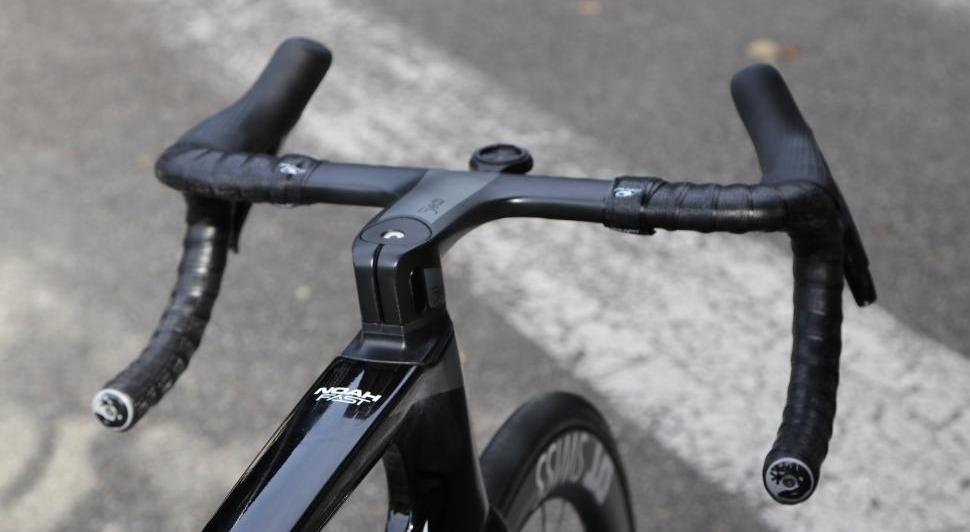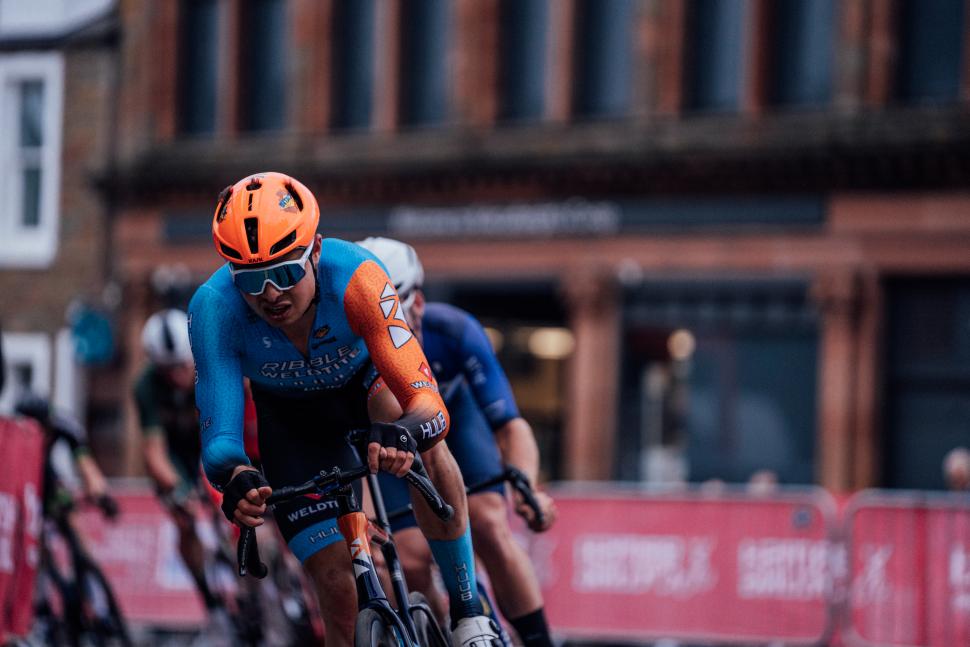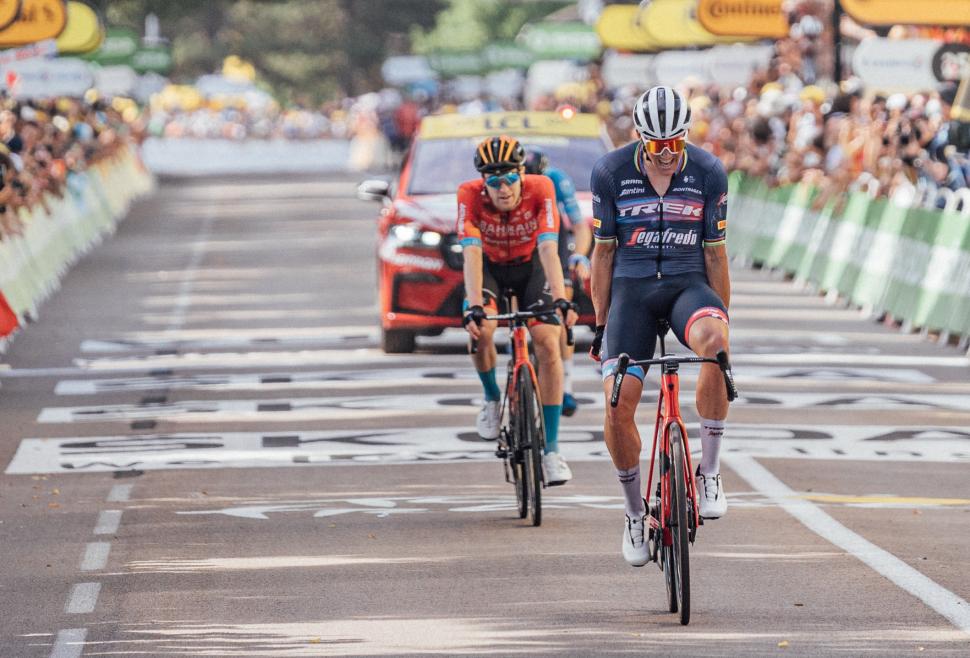- News
- Reviews
- Bikes
- Accessories
- Accessories - misc
- Computer mounts
- Bags
- Bar ends
- Bike bags & cases
- Bottle cages
- Bottles
- Cameras
- Car racks
- Child seats
- Computers
- Glasses
- GPS units
- Helmets
- Lights - front
- Lights - rear
- Lights - sets
- Locks
- Mirrors
- Mudguards
- Racks
- Pumps & CO2 inflators
- Puncture kits
- Reflectives
- Smart watches
- Stands and racks
- Trailers
- Clothing
- Components
- Bar tape & grips
- Bottom brackets
- Brake & gear cables
- Brake & STI levers
- Brake pads & spares
- Brakes
- Cassettes & freewheels
- Chains
- Chainsets & chainrings
- Derailleurs - front
- Derailleurs - rear
- Forks
- Gear levers & shifters
- Groupsets
- Handlebars & extensions
- Headsets
- Hubs
- Inner tubes
- Pedals
- Quick releases & skewers
- Saddles
- Seatposts
- Stems
- Wheels
- Tyres
- Health, fitness and nutrition
- Tools and workshop
- Miscellaneous
- Tubeless valves
- Buyers Guides
- Features
- Forum
- Recommends
- Podcast
TECH NEWS
 2022-dauphine-ridley-steff-cras levers bars
2022-dauphine-ridley-steff-cras levers bars UCI clamps down on narrow handlebars, pin-less number pockets and support car trickery
Sorry, Dan Bigham and Victor Campenaerts. Narrow handlebars, the latest fad for the aero conscious and a blight on the peloton for those of us more concerned with aesthetics, are being targeted as part of a new spate of regulations brought in by the UCI for 2023.
Other aerodynamic aids, such as pin-less race number pockets and the not-so-subtle modern trend of driving a team car inches behind a rider during a time trial (often with an unnecessary number of bikes stacked on said car’s roof), have also been addressed in the world governing body’s recently published ‘Clarification Guide of the UCI Technical Regulation’.
Over the past few years, the number of pro riders using narrow bars with even narrower shifter hoods – inspired, perhaps, by the UCI’s decision last year to ban the ‘puppy paws’ position on safety grounds and pioneered by the ultra-narrow and boundary-pushing Dutchman Jan Willem Van Schip – has increased dramatically, and has even found its way into the national, regional, and local racing scene.
At the British National Criterium Championships in June, for instance, Harry Tanfield was spotted sporting some rather extreme bars on his Ribble Ultra road bike (see below).
Zac Williams/SWPix.com
As our tech writer Jamie Williams pointed out earlier this year, the advantage of going to a narrower bar is of course aerodynamics – not from the bar itself but from the narrower frontal area it gives the rider.
Wind tunnel data is hard to come by but some quick maths using the known Cda (coefficient of aerodynamic drag) of a cylinder (standard round profile bar) indicates that the bars themselves contribute about 0.9 watts of additional drag for each 2cm gained when travelling at 40km/h. Rather negligible, then.
Of course, for pros obsessed with every aero (forgive me) marginal gain, it makes a much a larger difference. Most sources indicate that for every 2cm closer together you bring your hands there’s a 25W advantage when travelling at 40km/h, which is hardly marginal to be fair.
The fact that narrower bars can squeeze through tighter gaps, which in the hustle and bustle of road racing is very useful, means a number of Tour de France sprinters have opted for narrow, 38cm bars.
Zac Williams/SWPix.com
However, the UCI’s new regulations – set to come into effect on 1 January – appear to have nipped any inclination for riders to go considerably narrower than that in the bud.
While Article 1.3.012 of the UCI’s technical regulations only previously stipulated that the maximum width of a bike, and therefore its handlebars, must not exceed 500mm, the new rule also states that “the minimum overall width (outside – outside) of traditional handlebars (road events) and base bars (road and track events) is limited to 350mm.”
While the rule change should not affect any existing set-ups, it appears to have been brought in to stop any further advancements in narrow bar technology. The UCI being proactive, who would have thought it, eh?
Meanwhile, another rule change designed to counteract any future innovations concerns a rider’s reach.
An amendment to Article 1.3.022 now states that “in no case shall the front of the handlebars exceed the vertical plane passing at horizontal distance of 100 mm from the axis of the front wheel spindle”. This means that the very front of the bars cannot be positioned more then 100mm away from the hub, in effect outlawing less extreme versions of the controversial (and swiftly banned) Speeco Aero Breakaway Bar, briefly used by Van Schip in 2021.
Rules on time trial positions will also now be placed into three different categories (previously, only riders above 190cm tall were subject to relaxed regulations concerning positioning).
Speaking of time trial positioning, the now all-important placement of team cars behind TT riders – the subject of much controversy in June at the Critérium du Dauphiné after the Ineos Grenadiers’ staff members drove suspiciously closely behind Filippo Ganna with a raft of bikes stacked on top of the car – has also been placed under the UCI’s microscope.
Although we usually associate aerodynamics with the airflow over the cyclist from the front, effectively, teams can get a push effect by stacking the car in that way and following their rider at close proximity. The UCI has moved to counteract this aero benefit by stipulating that drivers are now required to remain 15 metres behind their charges during races against the clock.
This really needs to stop, on top of fact that car is likely too close to him anyway. Given calculations i've seen likely it gave him the win over Wout#Dauphine2022 pic.twitter.com/PRuyqTgY9G
— G Hofman (@letstalkcycling) June 9, 2022
A final aero gain du jour ruled out come 1 January is the controversial (for fans and commentators at least) use of race number pockets.
Used in time trials for several years, stick-on pocket sleeves for race numbers – like the ones produced by Nopinz – have become increasingly common in the pro peloton, even during road stages.
With road race skinsuits all the rage these days, more and more riders are now electing to forgo that sacred age-old tradition (experienced by Tour de France winners and cat four warriors alike) of securing their race number to their back pockets with safety pins, in favour of some extra aero gains.
> UCI “kindly requests” that riders stop using race number sleeves
However, ahead of this year’s Tour de France, the UCI kindly requested that, for visibility reasons, teams ditch the pin-less systems in favour of the good old-fashioned method.
Putting that request into law, article 1.3.029 requires that “no item of clothing may hide the lettering on the jersey or the rider’s identification number, particularly in competition and at official ceremonies,” though they will still be allowed in individual and team time trials, where riders are easier to identify.
Perhaps it’s time to finally introduce football-style numbers on the backs of jerseys?
Well, at least there are no changes to sock heights this year…
After obtaining a PhD, lecturing, and hosting a history podcast at Queen’s University Belfast, Ryan joined road.cc in December 2021 and since then has kept the site’s readers and listeners informed and enthralled (well at least occasionally) on news, the live blog, and the road.cc Podcast. After boarding a wrong bus at the world championships and ruining a good pair of jeans at the cyclocross, he now serves as road.cc’s senior news writer. Before his foray into cycling journalism, he wallowed in the equally pitiless world of academia, where he wrote a book about Victorian politics and droned on about cycling and bikes to classes of bored students (while taking every chance he could get to talk about cycling in print or on the radio). He can be found riding his bike very slowly around the narrow, scenic country lanes of Co. Down.
Latest Comments
- ErnieC 20 min 4 sec ago
No no no. Not unkind at all. Victim blaming perhaps (along with Tom_77) but certainly not unkind.
- hawkinspeter 14 min 37 sec ago
Depends on your age, I suppose. I still think of him as The Invisible Man or possibly Steel (not an element!)....
- ktache 1 hour 28 min ago
How's about, if you use active transport funding to fix a road it straightaway becomes default 20mph so everyone can use it in relative safety?
- ktache 1 hour 39 min ago
We have a new BKRY here in Cvrshm.
- pockstone 2 hours 25 min ago
Tried to like this and got 'threaded ' comments instead.
- Jakrayan 2 hours 39 min ago
Wouldn't they just charge your credit card rather than insist on a direct debit? And the cardholder's address is not shared with the merchant by...
- chrisonabike 2 hours 42 min ago
To be fair, he'd only be riding in a cycle lane where it wasn't a bus lane, a side road or a junction. Cycle lanes always vanish when one of those...
- qwerty360 3 hours 20 min ago
Remember, any driver flashing headlights for you to proceed should be assumed to be a crash for cash scam. ...
- Wheelywheelygood 4 hours 57 min ago
This is just a joke certainly in any tvp area they can't even police themselves let alone anything else all their interested in is fineing...
- scimos 5 hours 13 min ago
last time I went a few years ago seat tickets gave you access to the central area, yes.


Add new comment
12 comments
UCI, fat old has beens, grabbing money from where they can, they buggered up future development over the Lotus,a likes, anyone noticed the size of the track comisar in the latest track champs, even ordering the cameras abouit, BUT cant keep control of his figure, could be brother to Kirby.
Old news! They were doing that in 1933! (Not that pro cycling has anything to fear from me on my SpeedMachine...)
https://en.wikipedia.org/wiki/Francis_Faure#1933
Anyone know how many crashes were attributed to the puppy-paws 'stance', or was it purely a knee-jerk 'safety' reaction to detract attention from inadquate barriers and dangerous courses?
I am certainly no UCI fanboy, but if I recall correctly wasn't the rationale not so much to prevent pros crashing but to stop encouraging juniors and amateurs to imitate them? If that is the case I have to say, having been stuck behind some very wobbly puppy paws and supertuck imitators in Richmond Park, it wasn't a bad shout.
Juniors and middle aged men who should know better, I think
That might be the case, but it's a thin argument - wannabe spinters are far more dangerous. Besides which, it all happened at the time of complaints that the races were inconsiderate of rider safety, but those measures were distinctly victim-blaming in tone - "Our courses may be dangerous, but look at how they ride in places where they perceive no threat. We'll put an end to the that"
The bars shouldn't be an issue as the narrow bars like Ribbles and the new Aerocoach one flair enough at the drops. Number pockets would have been OK if it wasn't for some poor imitation ones that used mesh making the numbers hard to read. I understand manufactures probably wanted a material that was porous for sweat reasons but they ruined the whole concept Nopinz brought to market & managed to do without compromising number visibility.
To be fair, I think the challenge was more NoPinz patenting the see through plastic pocket, and then not making licensing to other companies possible / commercially viable.
Companies then created their own solutions, which as clear pockets were not viable, meant going down the mesh route.
Bit of a home goal in the end, however probably the right move seeing NoPinz's dominance of the UK time trial scene.
Been pushing that last point for a while now, every UCI team rider should have their own squad number (Team identifier plus number, so for example Remco would maybe be QST1) printed on the jersey, same one for all events in the season, number also on front of helmet. It would be so much easier to pick out riders both on TV and at the roadside, might even boost jersey sales as in soccer with fans wanting to buy their favourite rider's replica. Doubtless the UCI won't go for it because of "tradition".
You can't use space that could be occupied by a sponsor's logo.
Careful... you'll have Nick Freeman onto this!
My 34cm bars (C-C) measure 35.5 with thin tape. All i need now is a pro contract and my bars are legal